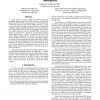Free Online Productivity Tools
i2Speak
i2Symbol
i2OCR
iTex2Img
iWeb2Print
iWeb2Shot
i2Type
iPdf2Split
iPdf2Merge
i2Bopomofo
i2Arabic
i2Style
i2Image
i2PDF
iLatex2Rtf
Sci2ools
FPGA
2000
ACM
2000
ACM
Automatic generation of FPGA routing architectures from high-level descriptions
In this paper we present a "high-level" FPGA architecture description language which lets FPGA architects succinctly and quickly describe an FPGA routing architecture. We then present an "architecture generator" built into the VPR CAD tool [1, 2] that converts this high-level architecture description into a detailed and completely specified flat FPGA architecture. This flat architecture is the representation with which CAD optimization and visualization modules typically work. By allowing FPGA researchers to specify an architecture at a high-level, an architecture generator enables quick and easy "what-if" experimentation with a wide range of FPGA architectures. The net effect is a more fully optimized final FPGA architecture. In contrast, when FPGA architects are forced to use more traditional methods of describing an FPGA (such as the manual specification of every switch in the basic tile of the FPGA), far less experimentation can be performed in the sa...
Related Content
| Added | 24 Aug 2010 |
| Updated | 24 Aug 2010 |
| Type | Conference |
| Year | 2000 |
| Where | FPGA |
| Authors | Vaughn Betz, Jonathan Rose |
Comments (0)

